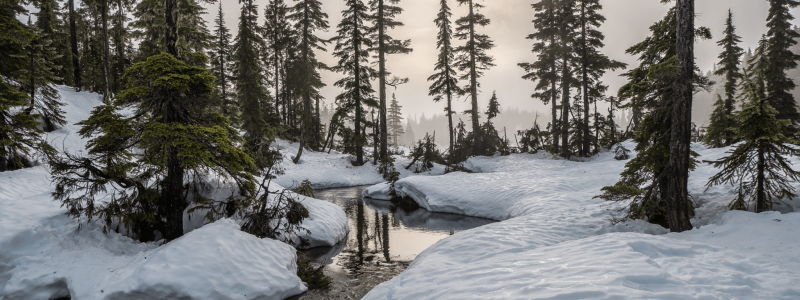As winter descends upon us, it brings with it a certain kind of magic. The world transforms into a serene landscape of snow-covered trees and shimmering icicles, painting a picturesque scene straight out of a holiday postcard. However, beneath the beauty, there are hidden risks and challenges that can be problematic for trees. In this blog, we’ll delve into the common types of tree damage witnessed during the winter months, the impact of fluctuating temperatures on tree health, and ways to protect your trees during the winter season.
Misconceptions About Winter Risks
Unfortunately, misconceptions about winter tree care exist. Some people may assume that trees can endure harsh winter conditions without any care or attention. This misunderstanding can lead to long-term damage and reduced tree lifespans. Proper tree care, including pruning, cabling, bracing, and monitoring for signs of damage, is essential to mitigate these risks.
Surprising Benefits of Heavy Snowfalls
While heavy snowfall may seem like a threat to trees, it can have some benefits as well. Snow can provide insulation, protecting tree roots from extreme cold and temperature fluctuations. However, this is beneficial only if the snow is not so heavy that it causes structural damage to the tree. Proper pruning and maintenance can help ensure that heavy snow does more good than harm.
Common Types of Tree Damage in Winter
Winter trees may seem invincible, but they are far more vulnerable than we often realize. One of the most common forms of tree damage during winter is caused by heavy snowfall. Wet snow, particularly in late fall or early spring when leaves are still on the trees, can be a significant menace. With the leaves acting like a magnet for snow, more snow accumulates on the branches, increasing the weight the tree must bear. This extra burden can lead to breakage and damage, both to the tree’s branches and its overall structure. Winter storms, with their powerful gusts and icy conditions, can exacerbate this issue, causing further harm to trees.
Another threat to trees during winter is the appetite of certain animals. Deer, squirrels, porcupines, and other creatures actively search for food during the harsh winter months. They often resort to nibbling on the foliage and bark of trees, depleting their energy reserves and potentially harming the trees’ long-term health.
Do Fluctuating Temperatures Hurt Trees?
While trees may appear dormant during the winter, they are not entirely unaffected by temperature fluctuations. In regions where winters are characterized by freeze-thaw cycles, like here in Salt Lake City, trees can be negatively impacted. Sudden freezes in early spring can stun budding leaves, potentially affecting the tree’s growth and vitality. These repeated temperature shocks can take a toll on a tree’s overall resilience and long-term health.
Similarly, in the fall, as trees prepare for winter by shedding their leaves, it’s essential that they undergo this process naturally. However, when trees are subjected to fluctuating temperatures, leaves might not change color and fall as they should. This can lead to the tree expending more energy to maintain leaves longer than necessary, which may weaken it in the long run.
What Types of Trees are Extra Vulnerable to Winter Damage?
Not all trees are equally susceptible to winter risks. Some species are more resilient, while others are more vulnerable. Additionally, where a tree is planted can make a significant difference. Trees that are not well-suited to the local climate or are planted in locations without natural protection from harsh winter conditions are at greater risk. It’s crucial to carefully consider the tree species and planting location to ensure their survival through the winter.
Winter Drought Conditions and Their Impact
Winter drought, a condition where trees suffer from insufficient moisture during the winter months, can be a deadly threat. Trees still require water to sustain themselves, even when they are dormant. Snow on the ground might give the impression of adequate moisture, but unless it melts and provides water for the tree’s roots, it won’t suffice. When the forecast predicts extended periods without moisture, it’s essential to provide supplemental watering to prevent winter drought from negatively impacting tree health.
Early Signs of Sunscald
Sunscald is another risk that trees face during winter, particularly those with smooth bark. It occurs when intense winter sun heats the bark during the day, causing it to expand, and then rapidly cools at night, causing the bark to contract. This temperature fluctuation can lead to damage in the form of cracks, discoloration, and cankers on the tree’s trunk.
Preserving Tree Health in Winter
To protect trees from winter-related risks, homeowners and property managers should take proactive measures. During dry periods, provide supplemental watering to ensure trees receive the moisture they need. After heavy snow or ice storms, be cautious when removing snow from tree branches. Vigorous shaking can damage the tree’s structure, so it’s often best to let the snow melt naturally.
Winter brings both beauty and danger to our trees. Understanding and addressing the risks associated with winter is essential to ensure the long-term health and survival of these essential natural assets. Planting the right trees in the right locations, taking precautions against winter drought, and addressing the impact of fluctuating temperatures are crucial steps to protect our trees during the coldest months of the year. By dispelling misconceptions and practicing proper tree care, we can help our trees weather the winter’s challenges and thrive in all seasons.

